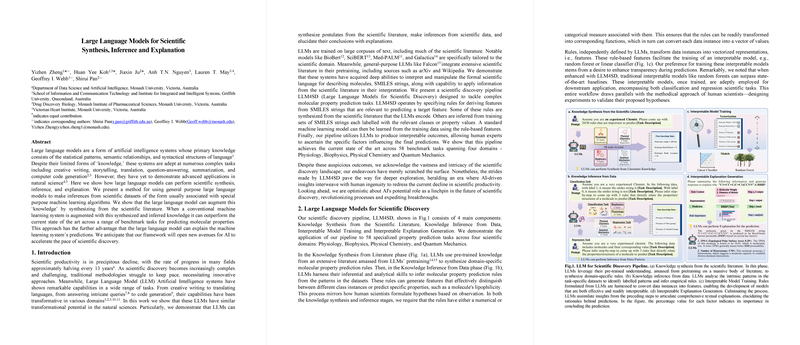LLMs for Scientific Synthesis, Inference and Explanation: An Analytical Overview
The paper presents an in-depth exploration of how LLMs can be applied in scientific synthesis, inference, and explanation, extending their known capabilities from creative writing, translation, and code generation to complex scientific tasks. By introducing the LLMs for Scientific Discovery (LLM4SD) pipeline, the authors provide a multifaceted approach for leveraging general-purpose LLMs to predict molecular properties, thereby achieving state-of-the-art (SOTA) results across diverse scientific domains.
Introduction
As scientific discovery becomes increasingly difficult and traditional methodologies struggle, the decline in scientific productivity—approximately halving every 13 years—necessitates novel approaches. The paper bridges this gap by proposing the deployment of LLMs for scientific synthesis, inference, and explanation, highlighting their potential in natural science domains. The LLM4SD pipeline encapsulates the following key functions:
- Knowledge Synthesis from Literature: LLMs mine large scientific datasets to derive domain-specific rules.
- Knowledge Inference from Data: LLMs infer rules from scientific data patterns.
- Interpretable Model Training: Using derived rules, models provide transparent and interpretable predictions.
- Interpretable Explanation Generation: LLMs offer comprehensive textual explanations for model predictions.
Experimental Results
Benchmark Performance
Empirical results indicate substantial improvements in LLM4SD over existing specialized supervised learning techniques. The performance of LLM4SD across 58 molecular property prediction tasks in physiology, biophysics, physical chemistry, and quantum mechanics showcased significant advancements:
- Physiology: Achieving an AUC-ROC of 76.60%, elevating the previous best from 74.43%.
- Biophysics: Enhancing AUC-ROC to 83.4% from 81.7%.
- Quantum Mechanics: Reducing MAE to 5.8233 from 11.2450, signifying a 48.2% improvement.
- Physical Chemistry: Achieving a notable MAE of 1.28, an 18.5% enhancement over the baseline.
These improvements underscore the robustness and versatility of LLM4SD, demonstrating superior efficacy in prediction tasks traditionally managed by highly specialized models.
Ablation Study
The ablation paper investigates the influence of LLM scale and pretraining datasets, revealing that domain-specific pretraining, as seen with the Galactica models, offers significant advantages. The comparison highlights the following:
- Scale Impact: Larger models generally performed better but not universally. For instance, Galactica-6.7b performed comparably to Galactica-30b in most areas except Quantum Mechanics, where the latter excelled. The broader applicability of large-scale, general-purpose models like Falcon-40b necessitates significant scale for scientific tasks.
- Pretraining Dataset Influence: The Galactica models, pretrained on scientific literature, outperformed the more general-purpose Falcon models, emphasizing the importance of domain-specific training.
Statistical Analysis and Literature Validation
The paper explores validating the rules generated by Galactica-6.7b through statistical tests and literature reviews, categorizing rules into three classes: statistically significant and literature-supported, statistically significant but not found in literature, and statistically insignificant. Notably, the synthesized rules were predominantly both statistically significant and literature-validated, whereas empirically inferred rules occasionally revealed novel insights not extensively documented. This outcome reflects the LLM's capacity to derive meaningful rules from data beyond textual memorization.
Discussion and Implications
The demonstrated capabilities of LLM4SD in synthesizing, inferring, and explaining scientific knowledge indicate significant potential for accelerating scientific discoveries and addressing the current decline in productivity. This pipeline's advantages include the ability to produce interpretable explanations, fostering greater trust and usability. However, the paper also acknowledges the parallel ethical challenges, particularly around the potential misuse of AI-driven discoveries in sensitive scientific domains.
Future Directions
The trajectory for LLM4SD is promising. Future work could explore the integration of more diverse tasks and domains, fostering enhanced collaboration between AI and human expertise in scientific research. Additionally, the continued development of a web-based application and the public release of datasets and code will facilitate broader accessibility and reproducibility.
Conclusion
The LLM4SD pipeline represents a significant step forward, not just in computational research, but in the broader scientific domain, offering a versatile, interpretable, and effective tool for scientific discovery. This paper sets the groundwork for future explorations, emphasizing the symbiotic potential between advanced AI models and human ingenuity in scientific research.
